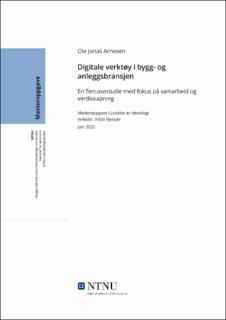| dc.contributor.advisor | Fjellvær, Hilde | |
| dc.contributor.author | Arnesen, Ole Jonas | |
| dc.date.accessioned | 2021-09-14T17:17:31Z | |
| dc.date.available | 2021-09-14T17:17:31Z | |
| dc.date.issued | 2020 | |
| dc.identifier | no.ntnu:inspera:55685251:61643465 | |
| dc.identifier.uri | https://hdl.handle.net/11250/2777220 | |
| dc.description.abstract | Bygg- og anleggsbransjen har lenge vært preget av fallende produktivitet. For å forbedre denne situasjonen har digitalisering blitt pekt ut som en avgjørende faktor. Det har blitt spådd til å bidra til en betydelig økning i bransjens verdiskapning. Men for at dette skal bli vellykket er det helt nødvendig at organisasjoner samarbeider og at byggherrer ser verdien i digitaliseringen. Formålet for denne studien er derfor å tydeliggjøre hvordan digitale verktøy bidrar med verdiskapning i samarbeid i bygg- og anleggsbransjen. Følgende problemstilling og to forskningsspørsmål ble derfor valgt for denne masteravhandlingen:
«Hvordan kan bruk av digitale verktøy på tvers av organisasjoner i bygg- og anleggsbransjen bidra til verdiskapning?»
1. «Hvilken verdi kan de digitale verktøyene bidra med til samarbeidene?»
2. «I hvilken grad blir de digitale verktøyene implementert på en slik måte at de kan gi verdi til samarbeidene?
Studien ble gjennomført med hjelp av en flercasestudie og kvalitative semistrukturerte intervju. Casene besto av fire ulike prosjekteringssamarbeid og tre prosjekteringsledere og åtte rådgivere utgjorde studiens informanter. Funnene fra datainnsamlingen ble videre knyttet sammen med de teoretiske hovedtemaene digitalisering, verdiskapning i samarbeid og strategisk implementering av ressurser og evner. Dette dannet grunnlaget for svarene på avhandlingens to forskningsspørsmål og følgende problemstillingen.
Funnene knyttet til forskningsspørsmål 1 tyder på verdien digitale verktøy bidrar med til samarbeidene varier etter hvilken type verktøy som brukes, men er totalt sett positivt. BIM-verktøy bidrar til store tidsbesparelser og er mer effektiv i å kontrollere for avvik. 3D-BIM gjør det også lettere å visualisere løsninger og bidrar til å øke kunnskapsdelingen internt i samarbeidene og mot kundene. På den andre siden brukes det mange kommunikasjonsverktøy samtidig og bidrar til økt kompleksitet. E-post ble i tillegg funnet til å være et dårlig egnet kommunikasjonsverktøy, da det bidrar til økte konflikter. Forskningsspørsmål to avdekket at verktøyene i liten grad blir implementert på slik måte at de kan gi verdi og samarbeidene har veldige begrensete evner til å identifisere og implementere nye løsninger. Eksplorering etter nye løsninger blir også for mye nedprioritert i forhold til utnytting av de eksisterende løsningene. Samarbeidene har derfor et stykke å gå for å oppnå den verdiskapningen som digitale verktøy kan bidra med. | |
| dc.description.abstract | The construction industry has long been affected by falling productivity. Digitalization has been selected as a decisive factor to improve this situation. This is predicted to contribute to a large increase in the industry's value creation. For this to be successful, it is necessary for organizations to collaborate and for construction owners to see the value in digitalization. The purpose of this study is to clarify how digital tools can contribute to value creation in collaboration in the construction industry. The following problem statement and research questions were chosen:
"How can the use of digital tools across organizations in the construction industry contribute to value creation?"
1. "What value can digital tools contribute witch to collaborations?"
2. "To what degree does the digital tools get implemented in such a way that they can contribute value to the collaboration?"
The study was conducted with the help of a multi-case study and qualitative semi-structured interviews. The cases consisted of four different design collaborations and three design managers and eight advisors made up the study's informants. The findings from the data collection were further linked together with the main theoretical themes of digitalization, value creation in collaborations and strategic implementation of resources and capabilities. This formed the basis for the answers to the two research questions and the problem statement.
The finding in research question 1 indicates that the value that digital tools contribute to the collaborations varies based on the tool used, but they are overall positive. BIM-tools contribute to large time savings and are more effective in controlling for deviation between blueprints. 3D-BIM also makes it easier to visualize solutions and this contributes to increases in knowledge exchange internally in collaborations and with customers. On the other hand, many different communication tools are used at the same time which contributes to unnecessary complexity. Email was additionally found to be a poorly suited communication tool as it increases the amount of conflicts. Research questions two uncovered that the tools to a small extent are implemented in such a way that they can provide value and the collaborations has limited capabilities to identify and implement new solutions. Exploration of new solutions is also under-prioritized in relation to the exploitation of the current solutions. The collaborations therefor have a long way to go to achieve the value creation that the digital tools can contribute with. | |
| dc.language | | |
| dc.publisher | NTNU | |
| dc.title | Digitale verktøy i bygg- og anleggsbransjen | |
| dc.type | Master thesis | |
